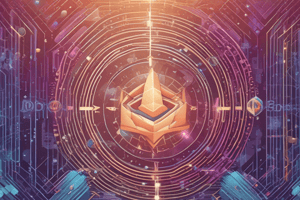Podcast
Questions and Answers
What is the primary purpose of a decentralized, distributed ledger technology like blockchain?
What is the primary purpose of a decentralized, distributed ledger technology like blockchain?
- To reduce the need for nodes in the network
- To facilitate faster transaction processing
- To increase the risk of single points of failure
- To ensure security and prevent tampering of transactions (correct)
What is the characteristic of blockchain that ensures data integrity?
What is the characteristic of blockchain that ensures data integrity?
- Immutability (correct)
- Decentralization
- Transparency
- Consensus
What is the role of nodes in a blockchain network?
What is the role of nodes in a blockchain network?
- To validate transactions using consensus mechanisms
- To store blockchain architecture
- To record transactions in blocks
- To participate in the network and maintain a copy of the blockchain (correct)
What is the significance of cryptocurrency Bitcoin in the history of blockchain?
What is the significance of cryptocurrency Bitcoin in the history of blockchain?
What is the purpose of a consensus mechanism in a blockchain network?
What is the purpose of a consensus mechanism in a blockchain network?
What is the primary benefit of blockchain technology in finance?
What is the primary benefit of blockchain technology in finance?
What is the purpose of smart contracts in blockchain technology?
What is the purpose of smart contracts in blockchain technology?
What is a major challenge facing blockchain technology?
What is a major challenge facing blockchain technology?
What is the expected future direction of blockchain technology?
What is the expected future direction of blockchain technology?
What is the purpose of decentralized applications (DApps) in blockchain technology?
What is the purpose of decentralized applications (DApps) in blockchain technology?
Study Notes
Decentralized Ledger Technology
- Primary purpose is to enable secure, transparent, and tamper-proof record-keeping without a central authority.
- Enhances trust among participants in the network by allowing for peer-to-peer transactions.
Data Integrity
- Data integrity is ensured through cryptographic hashing, creating a unique fingerprint for every block.
- Each block is linked to its predecessor, forming an immutable chain that prevents alterations to historical data.
Nodes in Blockchain
- Nodes act as individual participants in the network, maintaining a copy of the entire ledger.
- They validate transactions and blocks, ensuring consensus across the network.
Bitcoin and Blockchain History
- Bitcoin, launched in 2009, is the first cryptocurrency and a key innovation that popularized blockchain technology.
- It demonstrated the viability of decentralized finance systems and inspired numerous blockchain applications.
Consensus Mechanisms
- Consensus mechanisms, like Proof of Work or Proof of Stake, facilitate agreement among nodes to validate transactions.
- They ensure security and reliability, preventing double-spending and maintaining the integrity of the ledger.
Blockchain in Finance
- Primary benefit includes increased efficiency in transactions, reducing costs by eliminating intermediaries.
- Streamlines processes like cross-border payments and asset transfers, enhancing speed and transparency.
Smart Contracts
- Smart contracts are self-executing agreements coded onto the blockchain, facilitating automated transactions when conditions are met.
- They reduce the need for intermediaries and enhance trust and efficiency in executing contracts.
Challenges Facing Blockchain
- Major challenges include scalability, interoperability with existing systems, and regulatory uncertainty.
- Security vulnerabilities and energy consumption in some consensus mechanisms also pose significant hurdles.
Future Direction of Blockchain
- Expected future direction includes greater adoption in various industries beyond finance, such as supply chain and healthcare.
- Potential advancements in governance models and integration with emerging technologies like AI and IoT.
Decentralized Applications (DApps)
- DApps leverage blockchain features to provide user-centric services with a focus on transparency and decentralization.
- They help create ecosystems that are resistant to censorship and control by central authorities.
Studying That Suits You
Use AI to generate personalized quizzes and flashcards to suit your learning preferences.
Description
Test your understanding of blockchain, a decentralized, distributed ledger technology that ensures security and prevents tampering. Learn about its key components, including blocks, nodes, and consensus mechanisms. Discover the benefits of blockchain technology and its potential applications.




